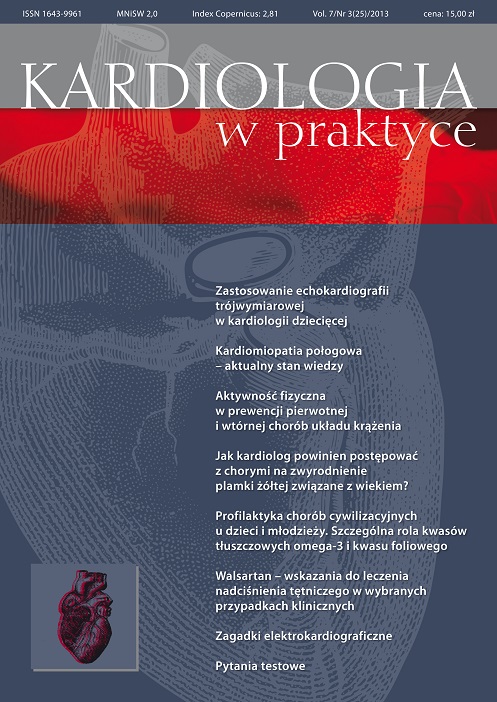The role of physical activity in prevention of cardiovascular diseases Review article
Main Article Content
Abstract
Cardiovascular diseases are a major cause of mortality in Poland and Europe. Despite the rapid development of new treatment techniques and pharmacotherapy, prevention remains the most effective method to reduce ones mortality from cardiovascular diseases. A sedentary lifestyle is one of the major risk factors for cardiovascular diseases. According to WHO approximately 60% of the world’s population is insufficiently active. There is a big gap between the guidelines of the scientific societies and its implementation to regular life.
Downloads
Article Details

This work is licensed under a Creative Commons Attribution-NonCommercial-NoDerivatives 4.0 International License.
Copyright: © Medical Education sp. z o.o. This is an Open Access article distributed under the terms of the Attribution-NonCommercial 4.0 International (CC BY-NC 4.0). License (https://creativecommons.org/licenses/by-nc/4.0/), allowing third parties to copy and redistribute the material in any medium or format and to remix, transform, and build upon the material, provided the original work is properly cited and states its license.
Address reprint requests to: Medical Education, Marcin Kuźma (marcin.kuzma@mededu.pl)
References
2. Mackay J., Mensah G.A., Mendis S. et al.: The Atlas of Heart Disease and Stroke. World Health Organization, Geneva 2004: 34-36.
3. Kearney J., Kearney M., McElhone S. et al.: Methods used to conduct the pan-European Union survey on consumer attitudes to physical activity, body weight and health. Public Health Nutr. 1999; 2: 79-86.
4. Drygas W., Skiba A., Bielecki W. et al.: Ocena aktywności fizycznej mieszkańców sześciu krajów europejskich. Projekt „Bridging East-West Health Gap”. Medicina Sportiva 2001; 5(suppl. 2): 119-128.
5. European Guidelines on cardiovascular disease prevention in clinical practice (version 2012). The Fifth Joint Task Force of the European Society of Cardiology and Other Societies on Cardiovascular Disease Prevention in Clinical Practice. Developed with the special contribution of European Association for Cardiovascular Prevention and Rehabilitation. Eur. Heart J. 2012; 33: 1635-1701.
6. Komisja ds. Opracowania Standardów Rehabilitacji Kardiologicznej PTK: Metody diagnostyczne w rehabilitacji kardiologicznej. Folia Cardiologica 2004; 11(suplement A): A1-A46.
7. Krysztofiak H., Szczypaczewska M., Chwalbińska-Moneta J. et al.: Programowanie aktywności fizycznej. W: Kardiologia Sportowa. Braksator W., Mamcarz A., Dłużniewski M. (red.). Via Medica, Gdańsk 2006: 225-238.
8. Piepoli M.F., Corra U., Benzer W. et al.: Secondary prevention through cardiac rehabilitation: physical activity counselling and exercise training. Eur. Heart J. 2010; 31: 1967-1974.
9. Skonieczny G., Jaworska-Drozdowska M., Jaworska K. et al.: Rehabilitacja kardiologiczna jako istotny element prewencji chorób układu krążenia. Rola samorządów terytorialnych. Hygeia Public Health 2013; 48: 194-199.
10. Piepoli M.F., Corra U., Benzer W. et al.: Secondary prevention through cardiac rehabilitation: from knowledge to implementation. A position paper from the Cardiac Rehabilitation Section of the European Association of Cardiovascular Prevention and Rehabilitation. Eur. J. Card. Prev. Rehab. 2010; 17: 1-17.
11. Vanhees L., Rauch B., Piepoli M.F. et al.: Importance of characteristics and modalities of physical activity and exercise in the management of cardiovascular health in individuals with cardiovascular disease (Part III). Eur. J. Prev. Cardiol. 2012; 19: 1333-1356.
12. Giannuzzi P., Mezzani A., Saner H. et al.: Physical activity for primary and secondary prevention. Position paper of the Working Group on Cardiac Rehabilitation and Exercise Physiology of the European Society of Cardiology. Eur. J. Cardiovasc. Prev. Rehabil. 2003; 10: 319-327.
13. Bjarnason-Wehrens B., McGee H., Zwisler A. et al.: Cardiac rehabilitation in Europe: results from the European Cardiac Rehabilitation Inventory Survey. Eur. J. Cardiovasc. Prev. Rehabil. 2010; 17: 410-418.
14. Sobieszczańska M.: Prewencja chorób sercowo-naczyniowych. Karkonoska Państwowa Szkoła Wyższa, 2011.

